

Reinforcement is applied to increase a likely behaviour and punishment is applied to decrease an unlikely behaviour. Parents can apply punishment and reinforcement in a negative or positive way to increase or decrease the behavioural outcome of the child.
I will share videos, notes and web articles here for parents to read and understand how to effectively used punishment and reinforcement to properly cultivate favourable behaviour traits in your teenage children.
Overview of Operant Conditioning Learning. Understanding on Reinforcement and Punishment. Learning Objectives Explain the difference between reinforcement and punishment (including positive and negative reinforcement and positive and negative punishment)Define shapingDifferentiate between primary and secondary reinforcers In discussing operant conditioning, we use several everyday words—positive, negative, reinforcement, and punishment—in a specialized manner.
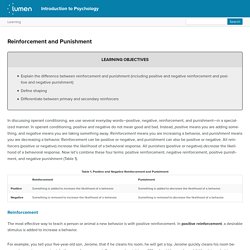
In operant conditioning, positive and negative do not mean good and bad. Instead, positive means you are adding something, and negative means you are taking something away. Reinforcement means you are increasing a behavior, and punishment means you are decreasing a behavior. Reinforcement vs Punishment.
Reinforcement and punishment are often used as parenting tools to modify children’s behavior.
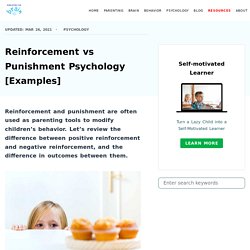
Let’s review the difference between positive reinforcement and negative reinforcement, and the difference in outcomes between them. The Difference Between Positive And Negative Reinforcement In behavioral psychology, reinforcement is the introduction of a favorable condition that will make the desired behavior more likely to happen, continue or strengthen in the future1. Because the favorable condition acts as a reward, reinforcement is a reward-based operant conditioning. Parenting Children with Positive Reinforcement. Children don’t come with instructions and discipline is often experienced by parents and children alike as an arena where our will and wits are tested.
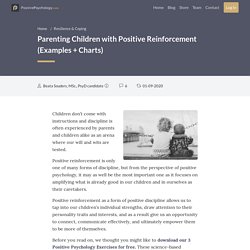
Positive reinforcement is only one of many forms of discipline, but from the perspective of positive psychology, it may as well be the most important one as it focuses on amplifying what is already good in our children and in ourselves as their caretakers. Positive reinforcement as a form of positive discipline allows us to tap into our children’s individual strengths, draw attention to their personality traits and interests, and as a result give us an opportunity to connect, communicate effectively, and ultimately empower them to be more of themselves. Parenting A Teen Through Positive Reinforcement. Most parents can agree: the teenage years can be rough!
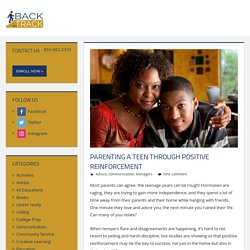
Hormones are raging, they are trying to gain more independence, and they spend a lot of time away from their parents and their home while hanging with friends. One minute they love and adore you, the next minute you ruined their life. Can many of you relate? When tempers flare and disagreements are happening, it’s hard to not resort to yelling and harsh discipline, but studies are showing us that positive reinforcement may be the key to success, not just in the home but also in their school life.
We’ve all heard the saying, “The one who is hardest to love needs love the most.” The Power of Positive Re-inforcement. Parenting Children with Negative Reinforcement. You've heard of negative reinforcement, but how do you put it into practice?
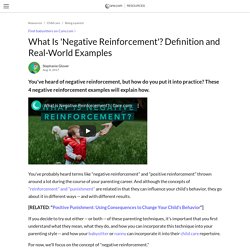
These 4 negative reinforcement examples will explain how. You've probably heard terms like "negative reinforcement" and "positive reinforcement" thrown around a lot during the course of your parenting career. And although the concepts of "reinforcement" and "punishment" are related in that they can influence your child's behavior, they go about it in different ways -- and with different results. [RELATED: "Positive Punishment: Using Consequences to Change Your Child's Behavior"] If you decide to try out either -- or both -- of these parenting techniques, it's important that you first understand what they mean, what they do, and how you can incorporate this technique into your parenting style -- and how your babysitter or nanny can incorporate it into their child care repertoire.
Why Negative Reinforcement Works Better as Your Child Grows into A Teen. If you are someone who has always loved the freedom of “no strings attached”, the idea of marrying and having kids could be quite underwhelming.

The idea of having a family always used to bug me, until I finally found the love of my life. It's when I categorically made up my mind about what I wanted from our marriage. Unwanted Effects of Reinforcement: The Bad Effects of a Good Intervention. Reinforcement is a highly recommended strategy in applied behavior analysis.
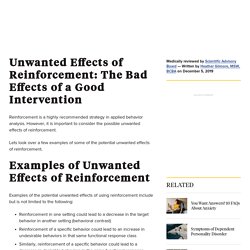
However, it is important to consider the possible unwanted effects of reinforcement. Lets look over a few examples of some of the potential unwanted effects of reinforcement. Positive Punishment To Change Children's Behaviour. Your child calls you a bad name and, as a result, you're making them scrub the toilet.
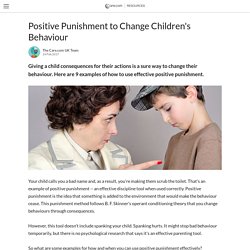
That's an example of positive punishment -- an effective discipline tool when used correctly. Positive punishment is the idea that something is added to the environment that would make the behaviour cease. This punishment method follows B. F. Skinner's operant conditioning theory that you change behaviours through consequences. Negative Punishment To Change Children's Behaviour. In this article, we will review negative punishment, its definition, examples, and drawbacks.
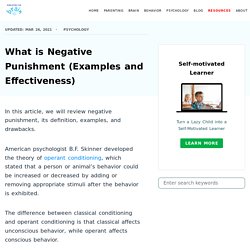
American psychologist B.F. Skinner developed the theory of operant conditioning, which stated that a person or animal’s behavior could be increased or decreased by adding or removing appropriate stimuli after the behavior is exhibited. The difference between classical conditioning and operant conditioning is that classical affects unconscious behavior, while operant affects conscious behavior. Types of Punishment – Which Type is Most Effective on Kids? Negative Consequences of Punishment. A person who has been punished is not less inclined to behave in a given way, at best, he learns how to avoid punishment.

B.F. Skinner.